Modeling and Simulations of 4H-SiC/6H-SiC/4H-SiC Single Quantum-Well Light Emitting Diode Using Diffusion Bonding Technique
Abstract
:1. Introduction
2. Materials and Methods
3. Results
3.1. Energy Band Profile and IV-Characteristics of Simulated LED
3.2. Luminous Power of Simulated SiC LED
3.3. Power Spectral Density of Simulated SiC LED
3.4. Calculations for Luminous Efficiency and External Quantum Efficiency of Simulated SiC LED
3.5. Comparison of Luminous Efficiency and External Quantum Efficiency of Simulated SiC LED with Literature
4. Conclusions
Author Contributions
Funding
Conflicts of Interest
References
- Round, H.J. A Note on Carborundum; Electrical World: Beograd, Serbia, 1907; Volume xlix, p. 309. [Google Scholar]
- Nakamura, S.; Mukai, T.; Senoh, M. Candela-class high-brightness InGaN/AlGaN double-heterostructure blue-light-emitting diodes. Appl. Phys. Lett. 1994, 64, 1687–1689. [Google Scholar] [CrossRef]
- Peralta, S.; Ruda, H. Applications for advanced solid-state lamps. IEEE Ind. Appl. Mag. 1998, 4, 31–42. [Google Scholar] [CrossRef]
- Makki, A.H.; Park, S.-H. Yellow Emissive Tris(8-hydroxyquinoline) Aluminum by the Incorporation of ZnO Quantum Dots for OLED Applications. Micromachines 2021, 12, 1173. [Google Scholar] [CrossRef] [PubMed]
- Yu, J.; Yu, S.; Fu, T.; Tang, Y. Micro-Prism Patterned Remote Phosphor Film for Enhanced Luminous Efficiency and Color Uniformity of Phosphor-Converted Light-Emitting Diodes. Micromachines 2021, 12, 1117. [Google Scholar] [CrossRef] [PubMed]
- Vu, T.H.Q.; Doan, T.T.; Jain, B.; Velpula, R.T.; Pham, T.C.T.; Nguyen, H.P.T.; Nguyen, H.-D. Improving Color Quality of Nanowire White Light-Emitting Diodes with Mn4+ Doped Fluoride Nanosheets. Micromachines 2021, 12, 965. [Google Scholar] [CrossRef] [PubMed]
- Chen, Z.; Ding, R.; Wu, F.; Wan, W. Lattice Constant Effect on Diffracted Transmission of ITO Periodic Nanostructures and Improvement of the Light Extraction Efficiency of Light-Emitting Diodes. Micromachines 2021, 12, 693. [Google Scholar] [CrossRef] [PubMed]
- Cinquino, M.; Prontera, C.T.; Pugliese, M.; Giannuzzi, R.; Taurino, D.; Gigli, G.; Maiorano, V. Light-Emitting Textiles: Device Architectures, Working Principles, and Applications. Micromachines 2021, 12, 652. [Google Scholar] [CrossRef] [PubMed]
- Nishizawa, N.; Munekata, H. Lateral-Type Spin-Photonics Devices: Development and Applications. Micromachines 2021, 12, 644. [Google Scholar] [CrossRef]
- Su, Z.; Zhao, B.; Gong, Z.; Peng, Y.; Bai, F.; Zheng, H.; Joo, S. Color-Tunable White LEDs with Single Chip Realized through Phosphor Pattern and Thermal-Modulating Optical Film. Micromachines 2021, 12, 421. [Google Scholar] [CrossRef]
- Kondrath, N.; Kazimierczuk, M. Characteristics and Applications of Silicon Carbide Power Devices in Power Electronics. Int. J. Electron. Telecommun. 2010, 56, 231–236. [Google Scholar] [CrossRef]
- Lohrmann, A.; Iwamoto, N.; Bodrog, Z.; Castelletto, S.; Ohshima, T.; Karle, T.; Gali, A.; Prawer, S.; McCallum, J.; Johnson, B. Single-photon emitting diode in silicon carbide. Nat. Commun. 2015, 6, 1–7. [Google Scholar] [CrossRef] [PubMed]
- Widmann, M.; Lee, S.-Y.; Rendler, T.; Son, N.T.; Fedder, H.; Paik, S.; Yang, L.-P.; Zhao, N.; Yang, S.; Booker, I.D.; et al. Coherent control of single spins in silicon carbide at room temperature. Nat. Mater. 2014, 14, 164–168. [Google Scholar] [CrossRef] [PubMed] [Green Version]
- Klimov, P.V.; Falk, A.L.; Buckley, B.B.; Awschalom, D.D. Electrically Driven Spin Resonance in Silicon Carbide Color Centers. Phys. Rev. Lett. 2014, 112. [Google Scholar] [CrossRef] [Green Version]
- Falk, A.L.; Klimov, P.V.; Buckley, B.B.; Ivády, V.; Abrikosov, I.A.; Calusine, G.; Koehl, W.F.; Gali, Á.; Awschalom, D.D. Electrically and Mechanically Tunable Electron Spins in Silicon Carbide Color Centers. Phys. Rev. Lett. 2014, 112, 187601. [Google Scholar] [CrossRef] [Green Version]
- Aharonovich, I.; Englund, D.; Toth, M. Solid-state single-photon emitters. Nat. Photonics 2016, 10, 631–641. [Google Scholar] [CrossRef]
- Fuchs, F.; Soltamov, V.A.; Väth, S.; Baranov, P.G.; Mokhov, E.N.; Astakhov, G.V.; Dyakonov, V. Silicon carbide light-emitting diode as a prospective room temperature source for single photons. Sci. Rep. 2013, 3, 1637. [Google Scholar] [CrossRef] [PubMed] [Green Version]
- Munthali, K.V. Current status of the technology of silicon carbide as a light conversion medium for nitride LEDs. J. Opt. 2019, 48, 76–80. [Google Scholar] [CrossRef]
- Manikandan, M.; Nirmal, D.; Prajoon, P.; Dhivyasri, G.; Chandran, V. Luminous power improvemnent in InGaN V-shaped quantum well led using CGS on SiC Substarte. Mater. Sci. Eng. 2020, 906, 012011. [Google Scholar]
- Lee, Y.-C.; Lu, T.-Y.; Lai, Y.-H.; Chen, H.-L.; Ma, D.-L.; Lee, C.-C.; Cheng, S.-C. Simulations of light extraction and light propagation properties of light emitting diodes featuring silicon carbide substrates. Opt. Mater. 2013, 35, 1236–1242. [Google Scholar] [CrossRef]
- Khramtsov, I.A.; Fedyanin, D.Y. Single-photon source based on novel color centers in Siliocn Carbide P-I-N diodes: Combining therory and experiment. Nano-Mincro Lett. 2021, 13, 1–12. [Google Scholar]
- Antoranz, P.; Miranda, J.M.; Sebastian, J.L. High-frequencymodeling of GaN/SiCble light emitting diodes. J. Appl. Phys. 2005, 97, 096107. [Google Scholar] [CrossRef] [Green Version]
- Castelletto, S. Silicon carbide single-photon sources: Challenges and prospects. Mater. Quantum Technol. 2021, 1, 023001. [Google Scholar] [CrossRef]
- Alferov, Z.I. The double heterostructure: Concept and its applications in physics, electronics and technology. Int. J. Mod. Phys. B 2002, 16, 647–675. [Google Scholar] [CrossRef]
- Rusnaldy, R. Diffusion Bonding: An Advanced of material process. Rotasi 2001, 3, 23–27. [Google Scholar]
- Kimoto, T. Bulk and epitaxial growth of silicon carbide. Prog. Cryst. Growth Charact. Mater. 2016, 62, 329–351. [Google Scholar] [CrossRef]
- Bergh, A.A.; Dean, P.J. Light Emitting Diodes; Clarendon Press: Oxford, UK, 1976. [Google Scholar]
- Kogan, L.M. Poluprovodnikovye Svetoizluchayushchie Diody (Semiconductor Light-Emitting Diodes); Energoizdat: Moscow, Russia, 1983. [Google Scholar]
- Fedorov, V.A.; Kozlov, S.A.; Potolokov, N.A.; Nikolashin, S.V. Preparation of high-purity gallium from semiconductor fabrication waste. Inorg. Mater. 2006, 42, S70–S89. [Google Scholar] [CrossRef]
- Sahakyan, A.; Koel, A.; Rang, T. Non-destructed eddy current measurements for Silicon carbide heterostructures analysis. WIT Trans. Eng. Sci. 2017, 116, 49–60. [Google Scholar]
- Toompu, J.; Sleptsuk, N.; Land, R.; Korolkov, O.; Rang, T. The measurement and tuning of SiC diode voltage doubler represented as diffusion-welded stack. In Proceedings of the 16th Biennial Baltic Electronics Conference (BEC), Tallinn, Estonia, 8–10 October 2018. [Google Scholar] [CrossRef]
- Sleptsuk, N.; Korolkov, O.; Toompuu, J.; Annus, P.; Rang, T. Comparative characteristics of diffusion welded high voltage stacks and connected in series Schottky diodes. In Proceedings of the 15th Biennial Baltic Electronics Conference (BEC), Tallinn, Estonia, 3–5 October 2016. [Google Scholar] [CrossRef]
- Korolkov, O.; Kozlovski, V.; Lebedev, A.; Land, R.; Sleptsuk, N.; Toompuu, J.; Rang, T. SiC Schottky Diode Rectifier Represented as Diffusion Welded Stack. Mater. Sci. Forum. 2017, 897, 697–700. [Google Scholar] [CrossRef]
- Anthony, J.; Will, H.A. Epitaxial growth of 6H-SiC in the temperature range of 1320–1390 °C. J. Appl. Phys. 1973, 5177–5178. [Google Scholar] [CrossRef]
- Tamura, S.; Fujihira, K.; Kimoto, T.; Matsunami, H. High-purity and thick 4H- and 6H-SiC(0001) epitaxial growth by cold-wall chemical vapor deposition and high-voltage pin diodes. Jpn. J. Appl. Phys. 2001, 40, L319–L322. [Google Scholar] [CrossRef]
- Kimoto, T.; Nishino, H.; Yoo, W.S.; Matsunami, H. Growth mechanism of 6H-SiC in step-controlled epitaxy. J. Appl. Phys. 1993, 73, 726–732. [Google Scholar] [CrossRef]
- Syvajarvi, M.; Yakimova, R.; Tuominen, M.; Kakanakova-georgieva, A.; MacMillan, M.F.; Henry, A.; Wahab, Q.; Janzen, E. Growth of 6H-SiC and 4H-SiC by sublimation epitaxy. J. Cryst. Growth 1999, 197, 155–162. [Google Scholar] [CrossRef]
- Isohashi, A.; Bui, P.V.; Toh, D.; Matsuyama, S.; Sano, Y.; Inagaki, K.; Morikawa, Y.; Yamauchi, K. Chemical etching of silicon carbide in pure water by using platinum catalyst. Appl. Phys. Lett. 2017, 110, 201601. [Google Scholar] [CrossRef] [PubMed] [Green Version]
- Kida, H.; Toh, D.; Bui, P.V.; Isohashi, A.; Ohnishi, R.; Matsuyama, S.; Yamauchi, K.; Sano, Y. High-Efficiency Planarization of SiC Wafers by Water-CARE (Catalyst-Referred Etching) Employing Photoelectrochemical Oxidation. Mater. Sci. Forum 2019, 963, 525–529. [Google Scholar] [CrossRef]
- Bhattacharya, A.; Baten, Z.; Frost, T.; Bhattacharya, P. Room Temperature GaN-Based Edge-Emitting Spin-Polarized Light Emitting Diode. IEEE Photon-Technol. Lett. 2017, 29, 338–341. [Google Scholar] [CrossRef]
- Kimoto, T.; Yonezawa, Y. Current status and perspectives of ultrahigh-voltage SiC power devices. Mater. Sci. Semicond. Process. 2018, 78, 43–56. [Google Scholar] [CrossRef]
- Cai, W.; Daehn, G.; Vivek, A.; Li, J.; Khan, H.; Mishra, R.S.; Komarasamy, M. A State-of-the-Art Review on Solid-State Metal Joining. J. Manuf. Sci. Eng. 2019, 141. [Google Scholar] [CrossRef]
- Dreyer, C.E.; Janotti, A.; Van De Walle, C.G.; Vanderbilt, D. Correct Implementation of Polarization Constants in Wurtzite Materials and Impact on III-Nitrides. Phys. Rev. X 2016, 6, 021038. [Google Scholar] [CrossRef]
- Caughey, D.M.; Thomas, R.E. Carrier mobilities in silicon empirically related to doping and field. Proc. IEEE 1967, 55, 2192–2193. [Google Scholar] [CrossRef]
- Selberherr, S. Process and Device Modeling for VLSI. Microelectron. Reliab. 1984, 24, 225–257. [Google Scholar] [CrossRef]
- Lades, M. Modeling and Simulation of Wide Bandgap Semiconductor Devices: 4H/6HSiC. Ph.D. Thesis, The Technical University of Munich, Munchen, Germany, 2000. [Google Scholar]
- SILVACO. Atlas User’s Manual; SILVACO: Santa Carla, CA, USA, 2016; Available online: www.silvaco.com (accessed on 22 October 2021).
- SILVACO. Tonyplot User’s Manual; SILVACO: Santa Carla, CA, USA, 2015; Available online: www.silvaco.com (accessed on 22 October 2021).
- Liu, Y.J.; Tsai, T.Y.; Yen, C.H.; Chen, L.Y.; Tsai, T.H.; Liu, W.C. Characteristics of a GaN-based light-emitting diode with an inserted p-GaN/i-InGaN superlattice structure. IEEE J. Quantum Electron. 2010, 46, 492–498. [Google Scholar] [CrossRef]
- Saroosh, R.; Tauqeer, T.; Afzal, S.; Mehmood, H. Performance enhancement of AlGaN/InGaN MQW LED with GaN/InGaN superlattice structure. IET Optoelectron. 2017, 11, 156–162. [Google Scholar] [CrossRef]
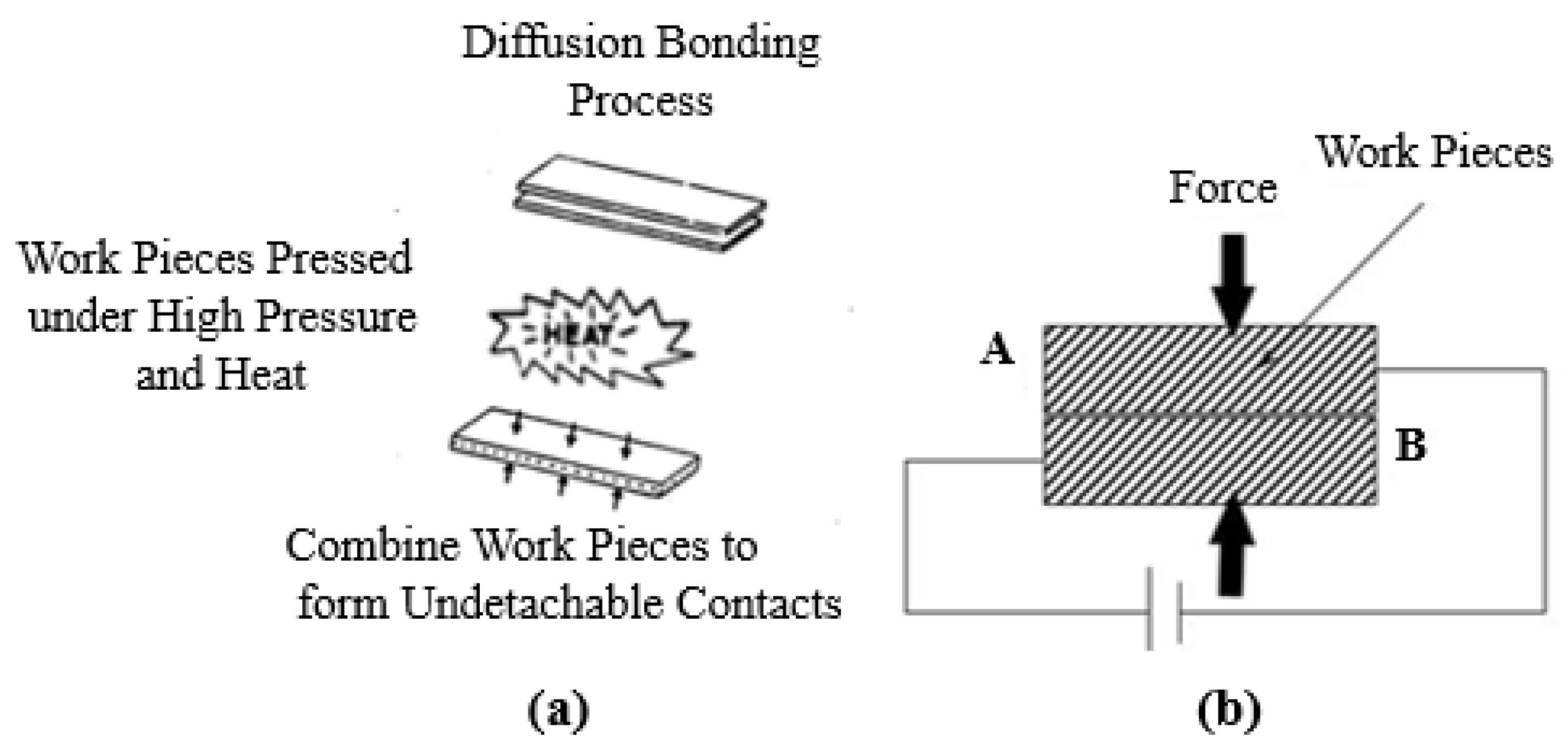
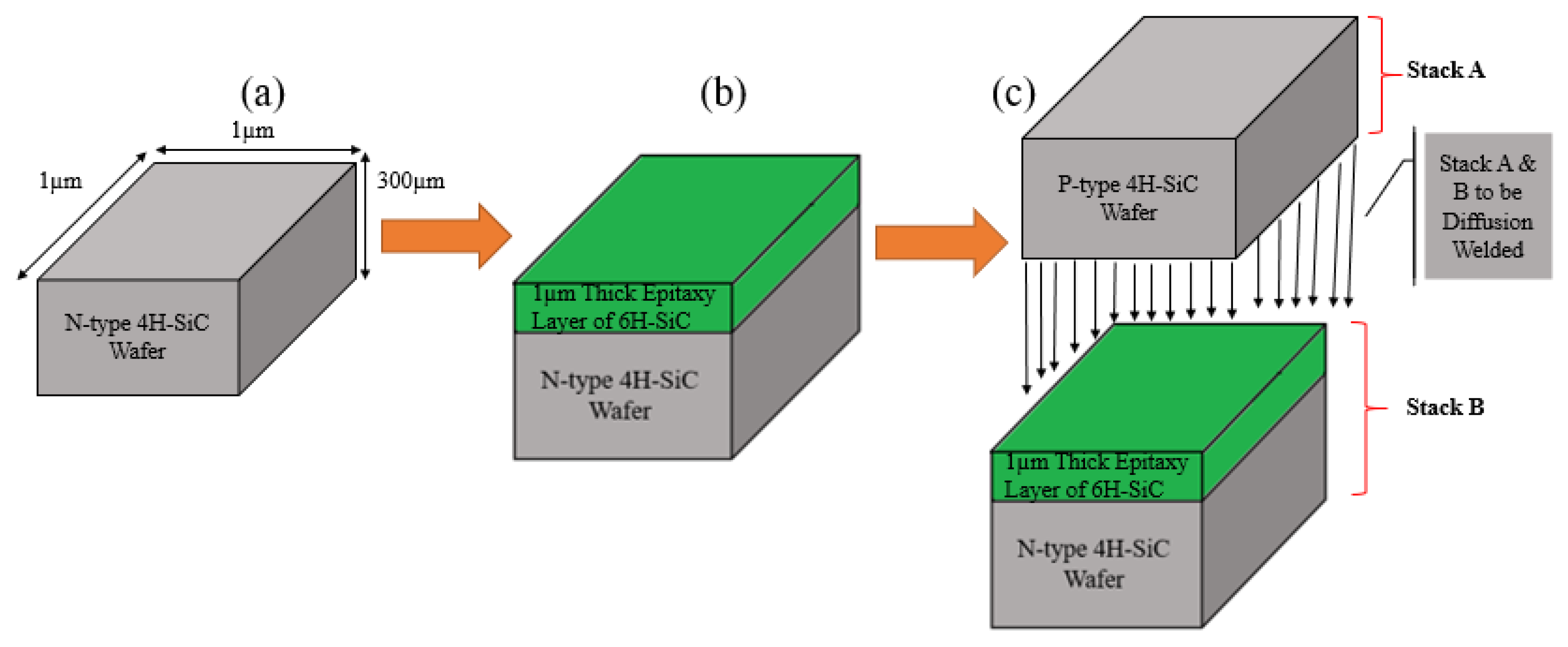
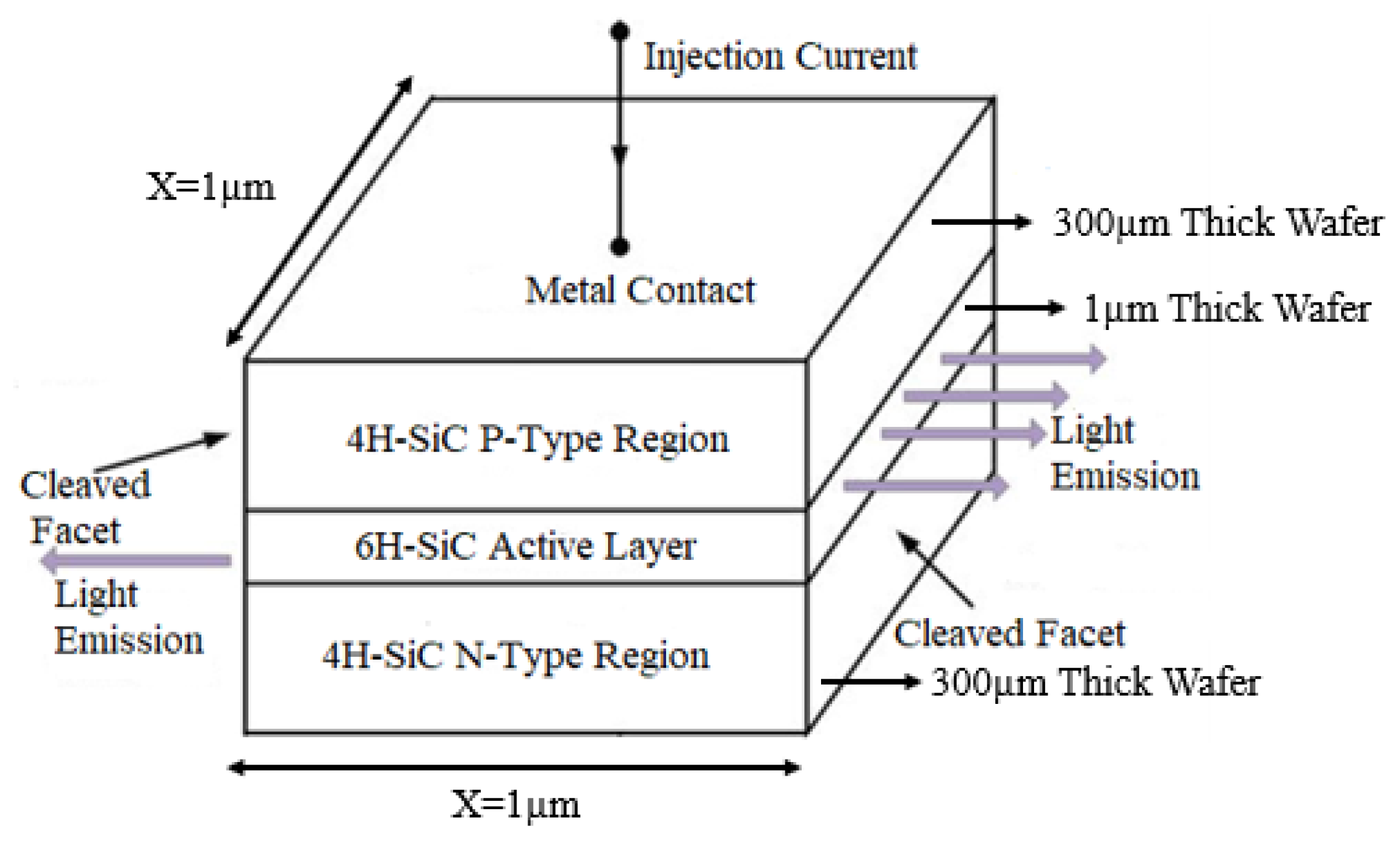
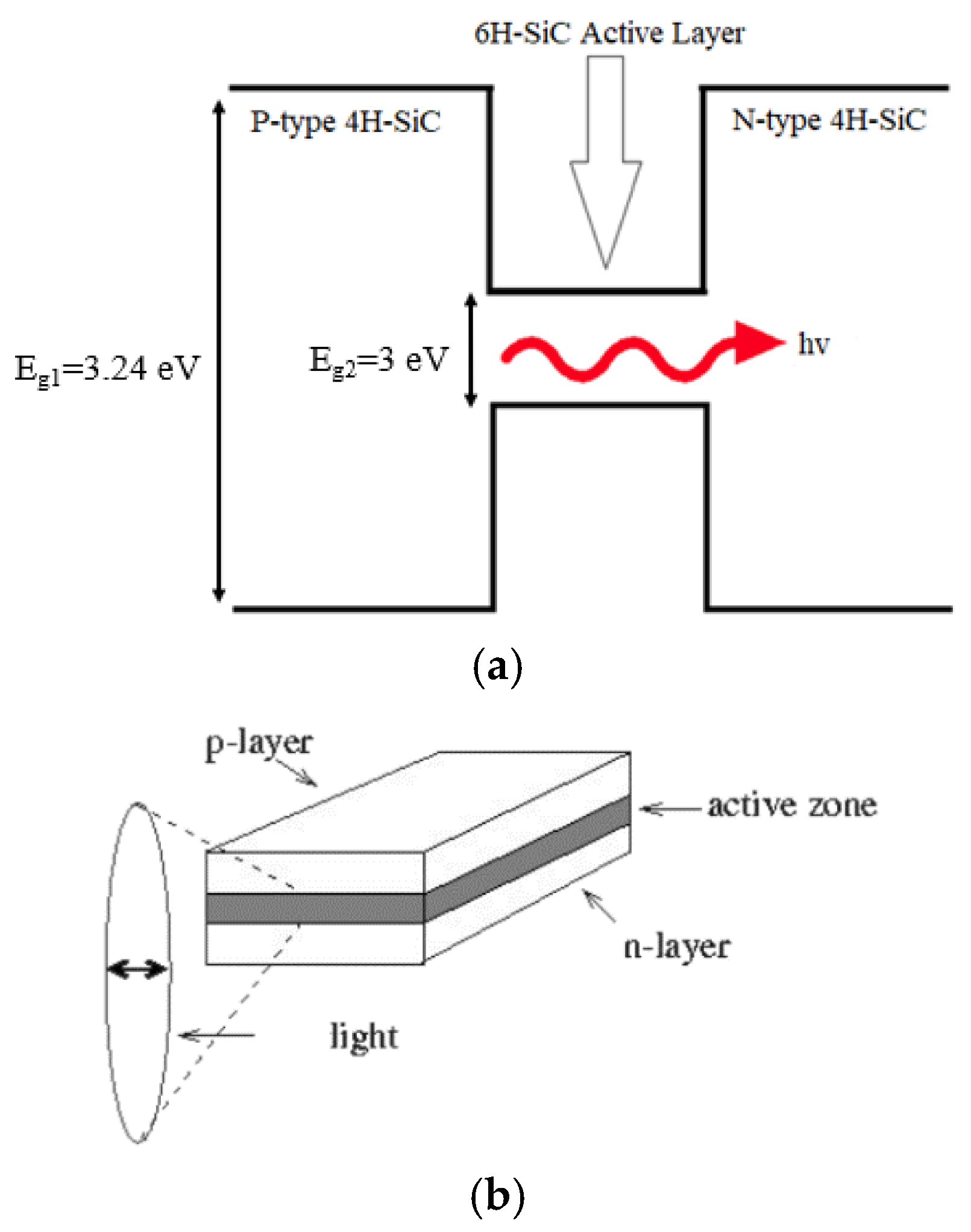
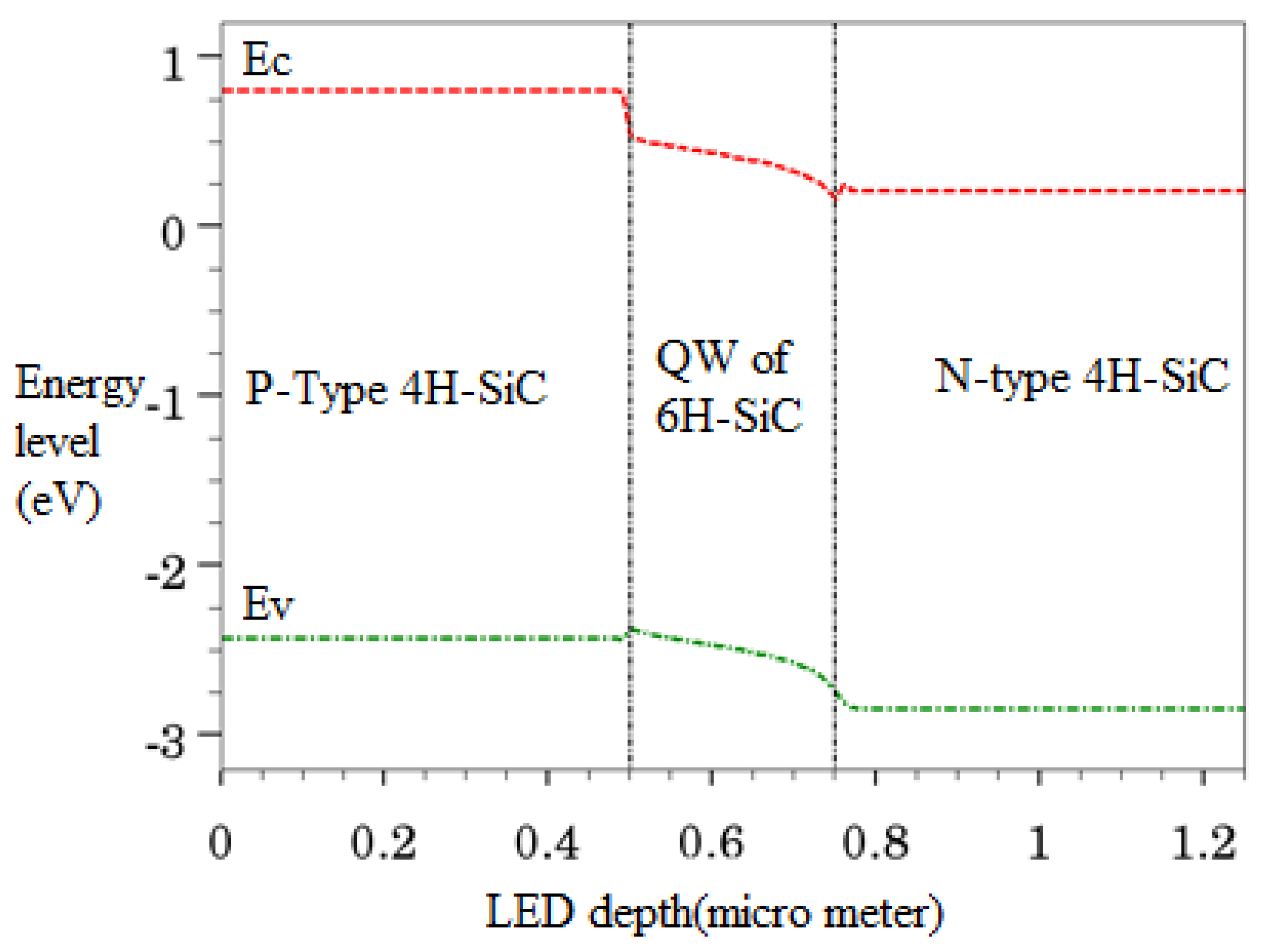
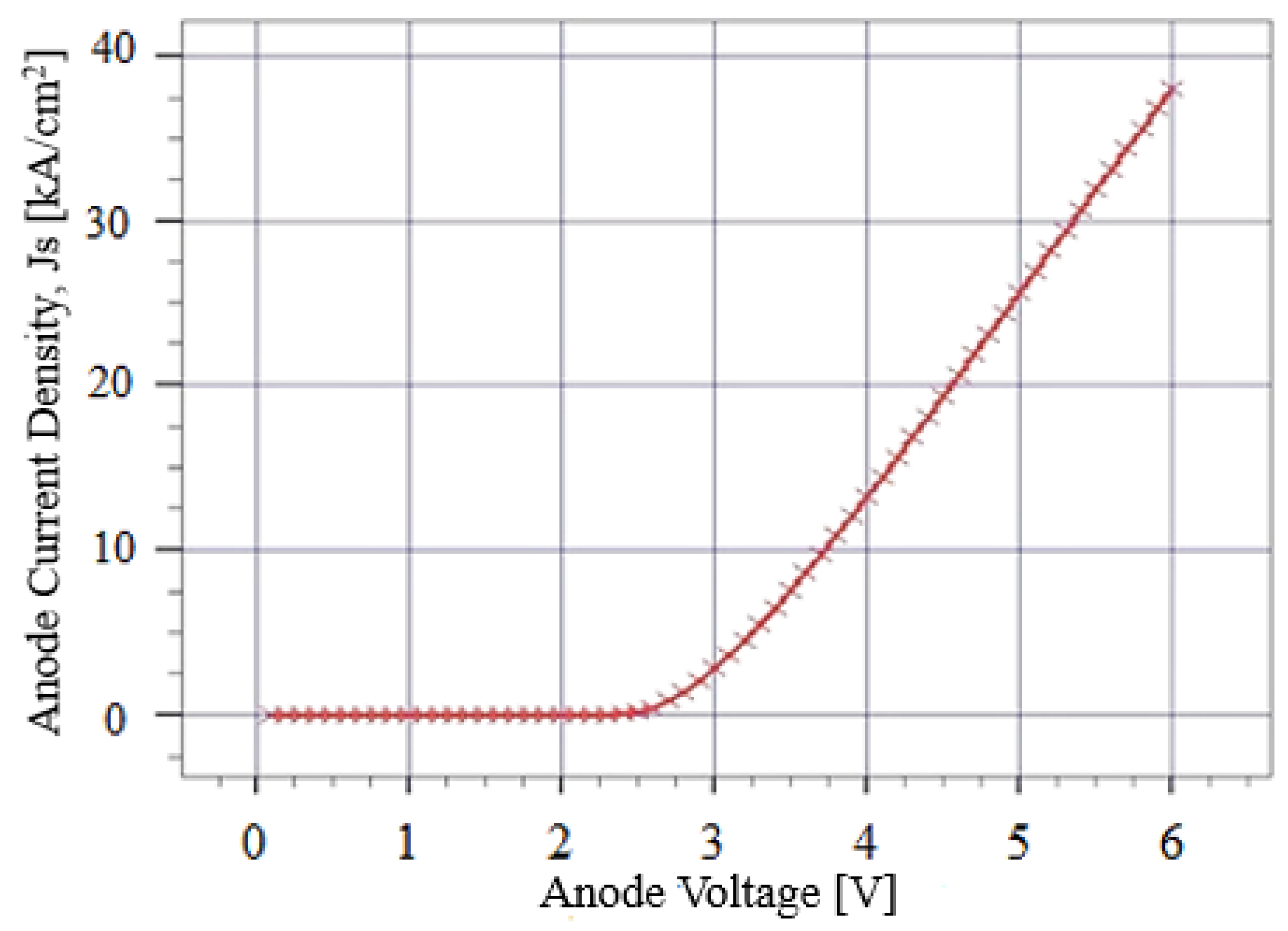

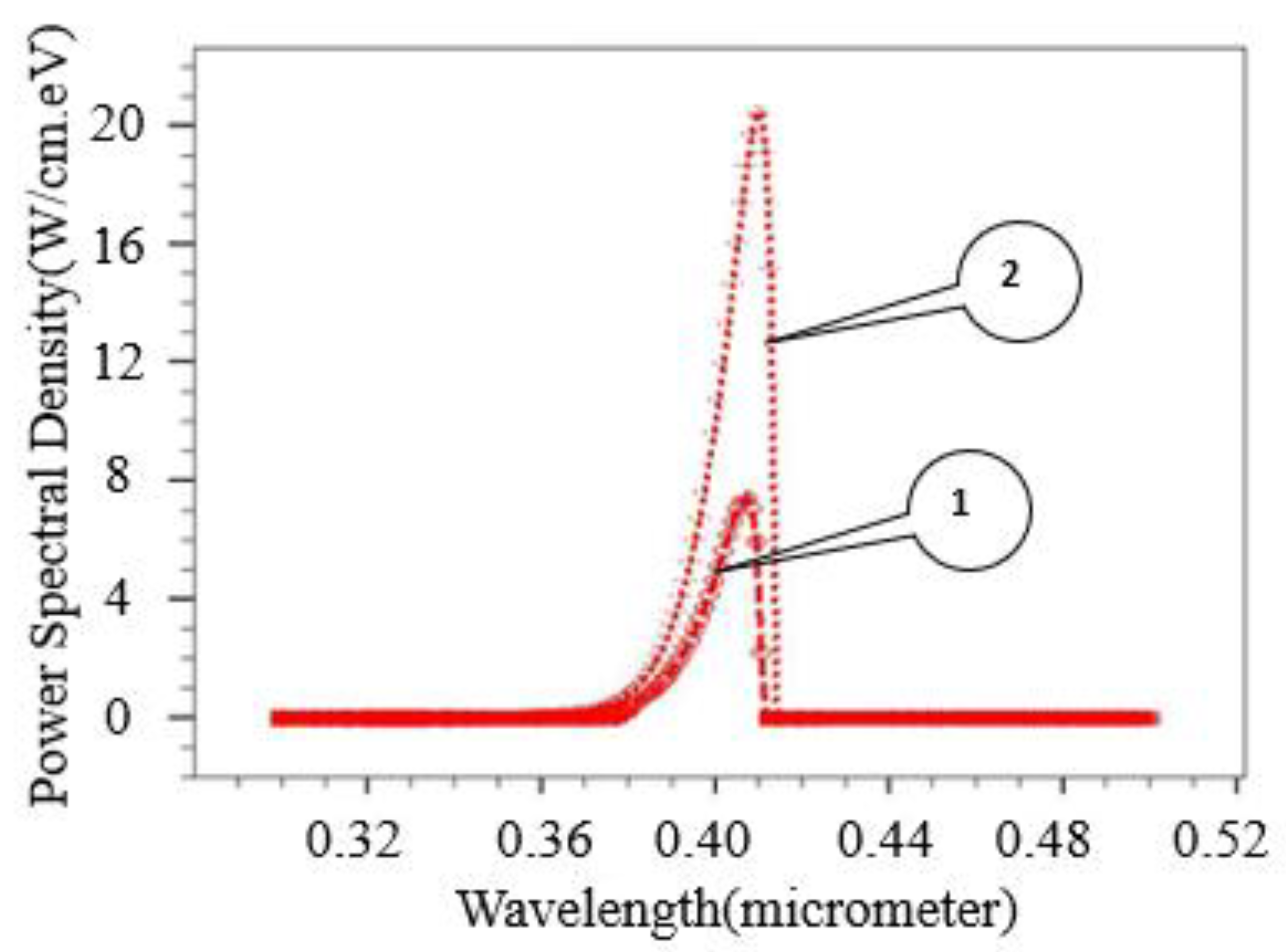
| Symbol | Quantity | Value |
|---|---|---|
| Eg1 | Bandgap of 4H-SiC | 3.24 eV |
| Eg2 | Bandgap of 6H-SiC | 3.00 eV |
| Permittivity | 6H-SiC | 9.66 |
| Permittivity | 4H-SiC | 9.7 |
| Affinity | 6H-SiC | 3.00 eV |
| Affinity | 4H-SiC | 3.24 eV |
| Nc | Electron density of states for 6H-SiC | 7.68 × 1018 cm−3 |
| Nc | Electron density of states for 4H-SiC | 1.66 × 1019 cm−3 |
| Nv | Holes density of states for 6H-SiC | 4.76 × 10+18 |
| Nv | Holes density of states for 4H-SiC(per cc) | 3.30 × 10+19 |
| el | Life time of electrons for 6H-SiC | 1.00 × 10−7 |
| el | Life time of electrons for 4H-SiC | 1.00 × 10−7 |
| ho | Life time of holes for 4H-SiC | 1.00 × 10−7 |
| ho | Life time of holes for 6H-SiC | 1.00 × 10−7 |
| MUNO | Mobility of electrons for 6H-SiC | 330 cm2/(V·s) |
| MUNO | Mobility of electrons for 4H-SiC | 440 cm2/(V·s) |
| MUPO | Mobility of holes for 6H-SiC | 300 cm2/(V·s) |
| MUPO | Mobility of holes for 4H-SiC | 124 cm2/(V·s) |
| Device | Radiative Rate cm3/s (r) | Recombination Rate cm3/s (T) | %Luminuous Efficiency (ƞ = r/T × 100) |
|---|---|---|---|
| SQW SiC LED | 5 × 1014 | 2 × 1015 | 25 |
| Device | Flux Spectral Density [s cm eV]−1 (Φ) | Bias Current kA/cm2 (Js) | %External Quantum Efficiency (%EQE = (q Φ/Js) × 100) |
|---|---|---|---|
| SQW SiC LED | 4 × 1019 | 39 | 16.43 |
| Device | Bias Current kA/cm2 (Js) | %Luminous Efficiency (ƞ = r/T × 100) |
|---|---|---|
| SQW SiC LED | 39 | 25 |
| Device A * | 5.62 | 79.8 |
| Device B * | 5.62 | 82.5 |
| Device C * | 5.62 | 81.0 |
| Device | Bias Current kA/cm2 (Js) | %External Quantum Efficiency (%EQE = (q Φ/Js) × 100) |
|---|---|---|
| SQW SiC LED | 39 | 16.43 |
| Device A * | 5.62 | 19.3 |
| Device B * | 12.32 | 25.4 |
| Device C * | 12.02 | 24.0 |
Publisher’s Note: MDPI stays neutral with regard to jurisdictional claims in published maps and institutional affiliations. |
© 2021 by the authors. Licensee MDPI, Basel, Switzerland. This article is an open access article distributed under the terms and conditions of the Creative Commons Attribution (CC BY) license (https://creativecommons.org/licenses/by/4.0/).
Share and Cite
Rashid, M.H.; Koel, A.; Rang, T.; Nasir, N.; Mehmood, H.; Cheema, S. Modeling and Simulations of 4H-SiC/6H-SiC/4H-SiC Single Quantum-Well Light Emitting Diode Using Diffusion Bonding Technique. Micromachines 2021, 12, 1499. https://doi.org/10.3390/mi12121499
Rashid MH, Koel A, Rang T, Nasir N, Mehmood H, Cheema S. Modeling and Simulations of 4H-SiC/6H-SiC/4H-SiC Single Quantum-Well Light Emitting Diode Using Diffusion Bonding Technique. Micromachines. 2021; 12(12):1499. https://doi.org/10.3390/mi12121499
Chicago/Turabian StyleRashid, Muhammad Haroon, Ants Koel, Toomas Rang, Nadeem Nasir, Haris Mehmood, and Salman Cheema. 2021. "Modeling and Simulations of 4H-SiC/6H-SiC/4H-SiC Single Quantum-Well Light Emitting Diode Using Diffusion Bonding Technique" Micromachines 12, no. 12: 1499. https://doi.org/10.3390/mi12121499






